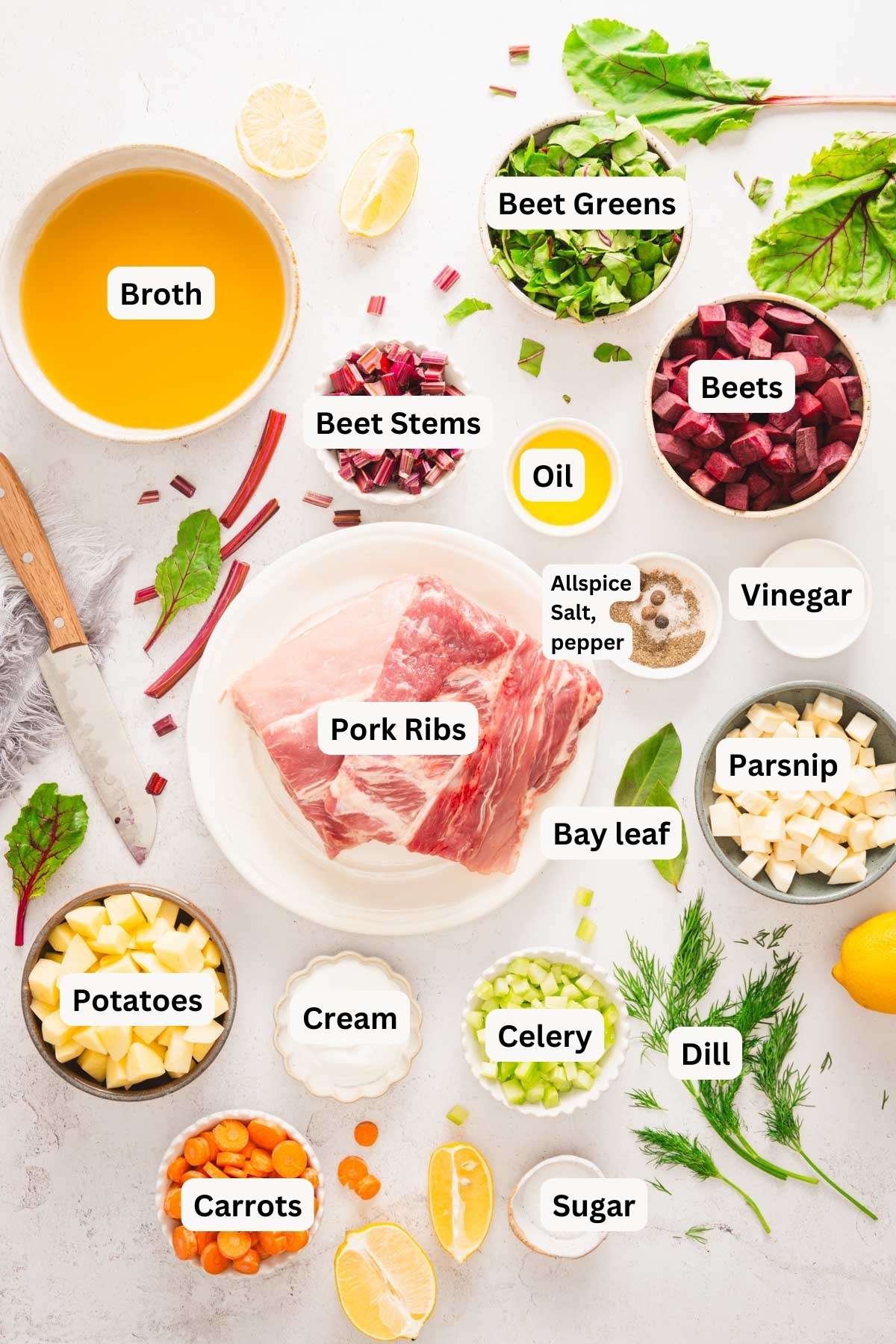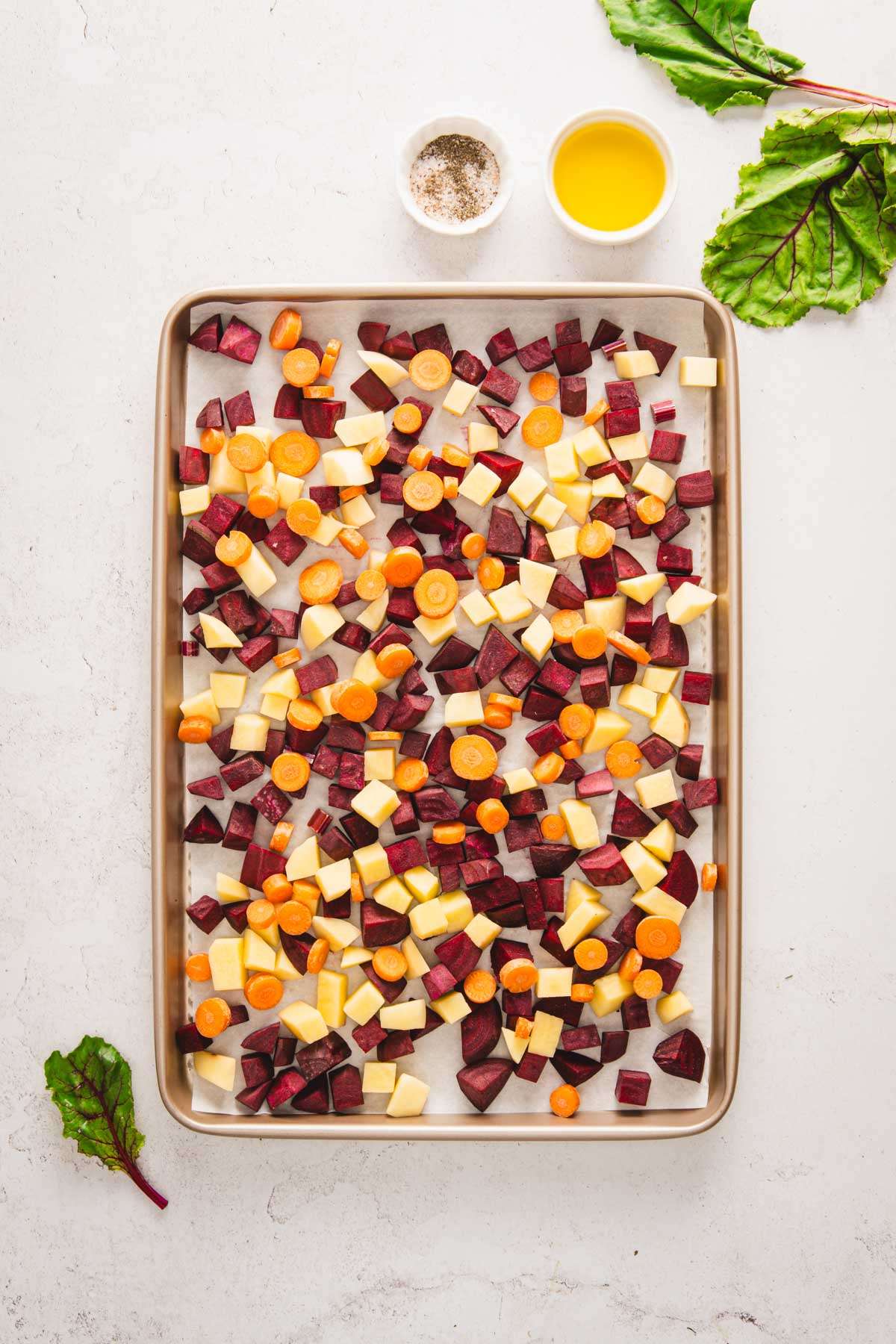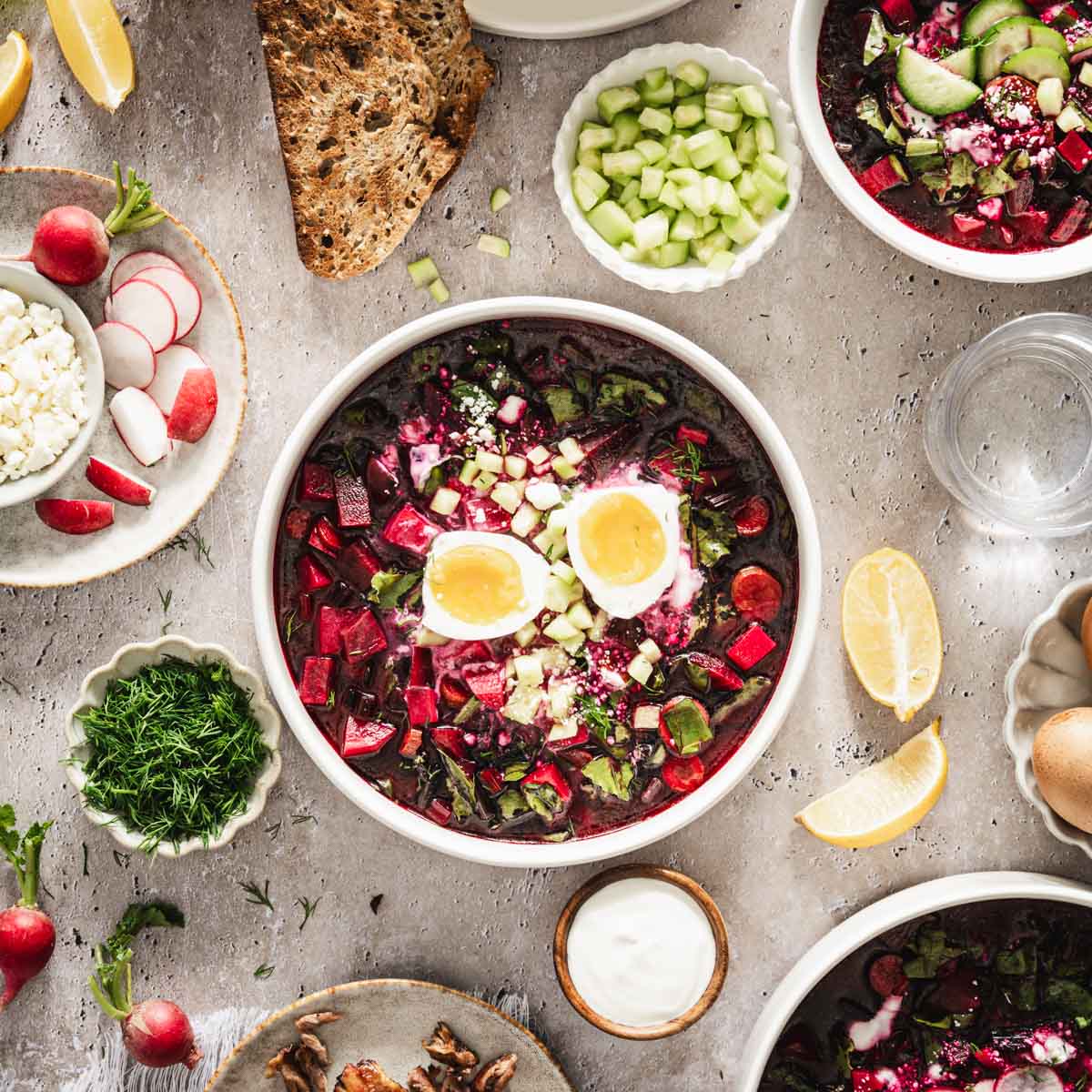Botwinka – Polish Young Beets and Greens Soup Recipe
This Polish beet soup, Botwinka, is filling yet light enough. Made from young beets and beetroot leaves and stems, it is bursting with the flavor of root vegetables and fresh herbs. The addition of potatoes and pork ribs makes it satisfying but not heavy.
The delicious soup balances sweet, tangy, and savory notes. The natural sweetness of the beets is complemented by the tanginess of lemon juice or vinegar, and the savory depth from the broth (especially if made with pork ribs) adds richness.

If you’re looking for new recipes that are quick and easy, this simple Botwinka soup is a perfect choice.
Next time you are at the Farmer’s market, pick a beautiful bunch of beets and make this famous Polish soup.
Follow the detailed instructions below to make this flavorful beet greens soup.

Why you will love Botwinka Soup
Rich, comforting taste – this simple beet soup balances sweet, tangy, and savory notes.
Nutritional benefits – loaded with vitamins, minerals, and antioxidants, while the greens provide a good dose of fiber and additional nutrients. The soup is not just delicious but also nourishing.
Hearty yet light – while Botwinka Soup is filling yet light enough to be enjoyed as a refreshing meal on warmer days.
Customizable – whether you prefer a vegetarian version with just vegetables or a heartier version with meat, Botwinka Soup can be tailored to suit different preferences.
Ingredients, Variations and Substitutions

Beets – the most important ingredient of this soup. Cutting them into small squares ensures they cook evenly and release their flavor into the broth. Make sure to wash the beets thoroughly, especially if you’re using the beetroot stems. If you can’t find small beets, larger ones will work, but they might need a bit more cooking time. Golden beets could be used, but they will change the color and flavor slightly.
Beet leaves – add an extra layer of flavor and nutrition to the soup, with a slightly bitter and earthy taste. If using, chop them finely and add towards the end of cooking to retain their color and nutrients. Swiss chard or spinach can be used if beet greens are unavailable.


Celery stalks – adds a subtle aromatic flavor and a bit of crunch, balancing the sweetness of the beets. Finely chopping ensures it blends well with the other vegetables. You can use celeriac for a stronger celery flavor or omit it for a simpler flavor profile.
Carrots – contribute sweetness and a slightly earthy flavor, complementing the beets. Parsnips can be used for a slightly spicier, earthier taste.
Potatoes – add body and creaminess to the soup as they cook and release their starch. Use a waxy potato that holds its shape well during cooking. Sweet potatoes or turnips can be used, though they will alter the flavor and sweetness.
Parsnip – adds a sweet, slightly nutty flavor and complements the other root vegetables. Parsley root can be used as an alternative.
Onion – provides a savory base flavor that enhances the richness of the soup. Dicing it finely ensures it melts into the soup, adding depth without being overpowering. Shallots or leeks can be used for a milder flavor.
Vegetable broth, stock – is the liquid base, infusing the soup with flavor. Adjust the amount based on your desired thickness for the soup. Chicken or beef stock can be used for a richer flavor, but veggie stock keeps it lighter and vegetarian-friendly (without the pork ribs). If you’re short on time, you can use a stock cube to create a flavorful veggie broth quickly.
Pork Ribs – add a rich, meaty flavor and depth to the broth, making the soup more hearty and satisfying. Brown the ribs first and simmer them slowly to extract the maximum flavor. Beef short ribs, smoked ham hocks, or chicken thighs can be used for different flavors.


Allspice Berries – adds warmth and complexity, giving the soup a subtle spiciness that enhances the other flavors. You can crush the berries slightly or roast them lightly to release more flavor. A pinch of ground allspice can be used if you don’t have berries, or you can substitute with a mix of cinnamon, nutmeg, and cloves. Caraway seeds are also a great option.
Bay Leaf – add a subtle depth and herbal note to the broth. Remember to remove the bay leaves before serving, as they’re not pleasant to eat. If you don’t have bay leaves, a small sprig of thyme can add a different herbal flavor.
Sugar – enhances the natural sweetness of the beets and other vegetables. Honey or maple syrup can be used for a different kind of sweetness, or it can be omitted entirely if the beets are sweet enough on their own.
Lemon Juice or White Vinegar – these acids balance the sweetness of the beets and other root vegetables, adding a tangy brightness to the soup. Add this at the end of cooking to preserve the fresh, bright flavor. Apple cider vinegar or red wine vinegar can be used if you prefer a different type of acidity.
Olive Oil – is used to sauté the vegetables, adding richness and aiding in the flavor release. Use a good-quality extra virgin olive oil for the best flavor. Butter or another neutral oil like sunflower oil can be used.
Salt and Black Pepper – both enhance the flavors in the soup, balancing sweetness and acidity. Start with less, and adjust to taste at the end.
Sour cream – adds a creamy, tangy flavor. It can be stirred in just before serving for added richness. You can also use Greek yogurt, heavy whipping cream, or even feta cheese.
Equipment you will need
- Oven
- Baking sheet with parchment paper
- Large stockpot or Dutch Oven
- Cutting board
- Chef’s Knife
- Wooden spoon or spatula
- Measuring spoons and cups
- Tongs
- Ladle
- Immersion blender (optional)

Top Tips
Use fresh, young beets – choose young, small beets with fresh, vibrant greens. The smaller beets are sweeter and more tender, perfect for the light, refreshing flavor of Botwinka.
Don’t overcook the beet greens – add the beet greens towards the end of cooking. Overcooking them can cause them to lose their vibrant color and tender texture. They should be wilted but still bright and fresh.
Roast the vegetables – roasting caramelizes their natural sugars, giving the soup a richer, more complex flavor.
Balance the acidity – adding lemon juice or vinegar balances the sweetness of the beets. Start with a small amount and adjust to taste, ensuring the soup has a nice tang without being too acidic.
Simmer, don’t boil – keep the heat at a simmer, not a rolling boil, especially after adding the pork ribs. This ensures the broth develops a rich flavor without becoming cloudy or toughening the meat.
Season gradually – taste the soup as you go and adjust the seasoning incrementally. Beets can have varying levels of sweetness, so you may need to tweak the salt, sugar, or vinegar for balance.
Rest the soup for better flavor – let the soup sit for a few hours or overnight in the refrigerator. The flavors will meld and deepen, making the soup even more delicious when reheated.
Use gloves – beets can stain cutting boards, countertops, and hands. Use gloves and consider laying down parchment paper on your work surface.


Step-by-step instructions
- Preheat the oven to 400°F (200°C)
- Start by preparing the beets. Cut off the stems and leaves. Using a brush, clean the beets under running water. Rinse the beet greens in cold water to remove any dirt and grit before cooking. You can also soak the beet greens in a bowl with cold water



- Cut the beets, carrots, and potatoes into small, uniform pieces. Toss the chopped beets, carrots, and potatoes in 1 tablespoon olive oil and season with salt and pepper.
- Spread the vegetables on a baking sheet and roast in the oven for 25-35 minutes, stirring halfway through or until they are tender and caramelized. Once done, set them aside.



- Add the pork ribs to a skillet and cook for a couple of minutes on each side until nicely browned. This will help develop the flavor of the broth.



- Remove the browned ribs and add the chopped celery and parsnip to the same skillet. Sauté until softened and slightly golden, about 5-7 minutes.



- Pour in the vegetable stock and scrape the browned bits from the bottom of the pot for extra flavor. Add the allspice berries, bay leaves, salt, and pepper.
- Bring the soup to a boil, then reduce the heat to low. Cover the pot and let it simmer for about 30 minutes, allowing the pork ribs to infuse the broth with their flavor.
- After the broth has simmered, add the roasted beets, carrots, and potatoes to the pot.



- Simmer the soup for another 10-15 minutes, allowing the flavors to meld together.
- If you’re using additional beetroot leaves, stir them into the soup during the last 5 minutes of cooking. This will wilt the greens slightly, adding extra nutrition and a pop of color.
- Stir in the lemon juice or vinegar to balance the sweetness of the beets and other vegetables.
- Add the sugar and taste the soup. If needed, adjust the seasoning with more salt, pepper, or sugar.
- Remove the pork ribs from the soup. You can cut the meat off the bones and return it to the soup or serve the meat alongside the soup.
- You can optionally use an immersion blender to blend part of the soup for a slightly creamy texture while still keeping some chunks for variety.
- Ladle the soup into bowls, garnish with fresh dill and enjoy.

Best way to enjoy Botwinka Soup
- Pair with crusty bread and a light salad
- Top with a dollop of sour cream, Greek yogurt or feta cheese
- Pair it with hard-boiled eggs or baby potatoes for a more filling meal
- Serve slightly chilled on warm days
- Pair with a light wine like Sauvignon Blanc or Pinot Grigio
- Serve with meat or fish and new potatoes for a complete meal.
You may also like:


Storage instructions, reheating
Let the Botwinka cool to room temperature before storing.
- Refrigeration:
- Store the soup in an airtight container for up to 3-4 days. The flavors will develop more, making the soup even tastier on the second day.
- Freezing (Optional):
- Portion the soup into smaller containers for easy reheating.
- For best texture, freeze the soup without the beet greens (you can add fresh greens when reheating). Frozen Botwinka can last for up to 2-3 months.
Reheating Instructions:
- Stovetop:
- Transfer the soup to a pot and reheat it on low to medium heat, stirring occasionally to ensure even heating.
- If the soup has thickened during storage, add a bit of vegetable stock or water to reach your preferred consistency.
- Microwave:
- Place a portion of the soup in a microwave-safe bowl.
- Cover the bowl with a microwave-safe lid or plate to avoid splattering.
- Heat in 1-minute intervals, stirring between each interval, until the soup is heated through.
- Reheating Frozen Botwinka:
- If frozen, thaw the soup in the refrigerator overnight before reheating.
- Follow the stovetop or microwave instructions above once thawed.
Tip for Freshness:
- Add fresh beet greens and a squeeze of lemon juice or a touch of vinegar after reheating to refresh the flavor and keep the soup vibrant!


Botwinka – Polish Young Beets and Greens Soup Recipe
Equipment
- oven
- baking sheet
- parchment paper
- large pot or Dutch oven
- measuring cups and spoons
- vegetable peeler
- cutting board
- chef's knife
- ladle, spoon, spatula
- immersion blender
Ingredients
- 6 small beetroots
- beetroot leaves and stems
- 1-2 sticks celery
- 2 carrots
- 2 potatoes
- 1 parsnip
- 3 tbsp sour cream
- 4-6 cups vegetable stock
- 1 lb pork ribs
- 2 tbsp olive oil
- 2 tbsp lemon juice or white vinegar
- 1 tablespoon unrefined sugar
- 6 allspice berries
- 2 bay leaves
- 1 tsp salt
- 1 tsp black pepper
Instructions
- Start by preparing the beets. Cut off the stems and leaves. Using a brush, clean the beets under running water. Rinse the beet greens in cold water to remove any dirt and grit before cooking. You can also soak the beet greens in a bowl with cold water
- Cut the beets, carrots, and potatoes into small, uniform pieces. Toss the chopped beets, carrots, and potatoes in 1 tablespoon olive oil and season with salt and pepper.
- Spread the vegetables on a baking sheet and roast in the oven for 25-35 minutes, stirring halfway through or until they are tender and caramelized. Once done, set them aside.
- Add the pork ribs to a skillet and cook for a couple of minutes on each side until nicely browned. This will help develop the flavor of the broth
- Remove the browned ribs and add the chopped celery and parsnip to the same skillet. Sauté until softened and slightly golden, about 5-7 minutes.
- Pour in the vegetable stock and scrape the browned bits from the bottom of the pot for extra flavor. Add the allspice berries, bay leaves, salt, and pepper.
- Bring the soup to a boil, then reduce the heat to low. Cover the pot and let it simmer for about 30 minutes, allowing the pork ribs to infuse the broth with their flavor.
- After the broth has simmered, add the roasted beets, carrots, and potatoes to the pot.
- Simmer the soup for another 10-15 minutes, allowing the flavors to meld together.
- If you’re using additional beetroot leaves, stir them into the soup during the last 5 minutes of cooking. This will wilt the greens slightly, adding extra nutrition and a pop of color.
- Stir in the lemon juice or vinegar to balance the sweetness of the beets and other vegetables.
- Add the sugar and taste the soup. If needed, adjust the seasoning with more salt, pepper, or sugar.
- Remove the pork ribs from the soup. You can cut the meat off the bones and return it to the soup or serve the meat alongside the soup.
- You can optionally use an immersion blender to blend part of the soup for a slightly creamy texture while still keeping some chunks for variety.
- Ladle the soup into bowls, garnish with fresh dill and enjoy.
Notes
Nutrition
Did you make this recipe?
Tag me @sylwiavaclavekphotography or tag me using #myomnikitchen so I can see your creations! You can also leave a comment below!
Conclusion
Botwinka soup is a delicious, comforting soup that brings together the sweetness of beets and fresh vegetables in a vibrant dish that’s perfect for any time of year.
Young beet soup is typically enjoyed during the early summer months when young beet leaves are at their best, but also tastes delicious in the Fall . Whether served warm with a dollop of sour cream or chilled as a summer treat, this traditional Polish soup is full of flavor.
While Borscht is the most famous Polish soup, Botwinka is a lesser-known but equally delicious traditional soup celebrating the beet harvest. You can make this delightful soup by following the instructions, simple substitutions, and helpful tips in this blog post. Plus, it stores and reheats well, making it a great option for meal prepping or enjoying over a few days!


FAQ
What is Botwinka?
Botwinka is a traditional Polish soup made from young beetroot, including beet greens and stems. It’s a light, flavorful soup often enjoyed in the spring or summer, highlighting the fresh, earthy sweetness of the beets.
Can I make Botwinka without pork ribs?
Absolutely! While pork ribs add richness and depth to the broth, you can substitute them with chicken or beef or even omit the meat entirely for a vegetarian version. A vegetable or mushroom broth works well in place of meat stock.
How long does Botwinka last in the fridge?
Botwinka can be stored in an airtight container in the refrigerator for 3-4 days. The flavors often improve after a day, making it an excellent dish for leftovers.
Can I freeze Botwinka?
You can freeze Botwinka, but it’s best to freeze it without the beet greens for optimal texture. Store in portion-sized containers, which can last up to 2-3 months in the freezer. Add fresh beet greens when reheating.
Can I substitute beet greens if I don’t have them?
Yes! If beet greens are unavailable, you can substitute spinach, Swiss chard, or kale. These leafy greens will give the soup a similar texture and color.
How can I adjust the tanginess of the soup?
To adjust the tanginess, start with a small amount of lemon juice or red wine vinegar and add more to taste. The acid balances the sweetness of the beets, so feel free to tweak it according to your preference.








